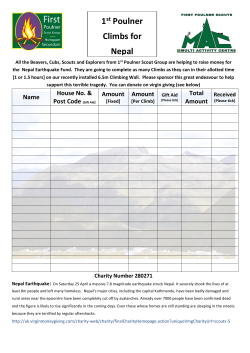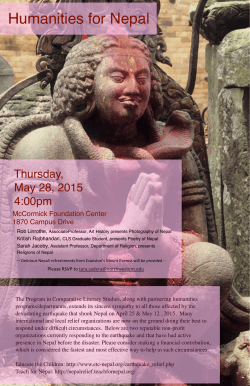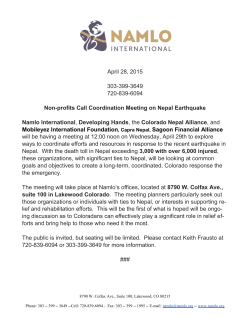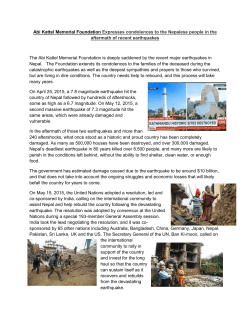
Nepal Earthquake 2015 Foreign Medical Team Coordination
Nepal Earthquake 2015 Foreign Medical Team Coordination Meeting Minutes Wednesday 29 th April 2015 1. Welcome, opening comments Dr. Kem Kharki (MOHP focal point for International Teams) and Dr. Ian Norton (WHO coordinator for Foreign Medical Teams, FMT) opened meeting. The meeting intent is an operationally focussed daily Coordination meeting for teams providing medical and health related care to the population affected by the Earthquake. 2. Introductions/attendees Partner name Rescue Net Norway Red Cross Canadian Red Cross Japan Red Cross Qatar Red Crescent Americares IOM UK Govt/Save the Children Italy Rubicon/Amercian Nepal foundation Ways for water JICA (Japanese Govt) Handicap International Capability Type 1 Type 2 Type 2 Type 1 Type 1 Type 1 (two teams) Nil Type 2 without facility Israel Defence Force Humedica (Germany) Type 3 Type 1 with light surgical capacity Type 1 mobile Type 1, but can become 2 if needed Ortho-plastics specialist team Type 1 Nil Lands AID (Germany) IMC MdM Spain NATAN (Israel) Nick Simmons Institute Comments 60 beds 40 beds +MCH component 15-20 beds 10-15 beds Camp management Type 2 Type 1 mobile Nil Type 2 Specialist rehab services Provides WASH Physiotherapists etc working in national hospitals To work in national hospital Curative services in Nepal hospitals programme WHO MOHP UNDAC-UNOCHA 3. Operational briefing Overview of impact on health system, numbers of casualties and current known FMTs deployed was shared. Up to 90% of primary health care structures in the 11 Nepal Earthquake 2015 Foreign Medical Team Coordination Meeting Minutes Wednesday 29 th April 2015 most affected districts have been damaged or destroyed. 3 district hospitals have been damaged and are not usable, requiring Field Hospital substitution. • • • Chautara, Sindulpalchock Bidur, Nuwakot Dhunche, Rasuwa The ministry decided to institute a “hub and spoke” approach to placement of large teams in strategic locations based on previously existing hospitals and health care facilities, and with extra placement according trauma load. From each “hub” mobile teams, or smaller type 1 facilities will be dispatched to the remoter areas, to allow remaining trauma cases to be either treated or referred to the next level of care, including back to tertiary level care at the Kathmandu hospitals. Large numbers (over 10) military field hospitals have been deployed from the armies of India, China, Israel, Pakistan, Bangladesh, Sri Lanka, Singapore and Bhutan. 4. Information for partners FMTs were asked to register using the following process; • • • Register with either the WHO prior to arrival in Nepal, or with the Reception and Departure Centre (RDC) at the airport. Proceed to the Ministry of Health headquarters for certification procedures and tasking, bringing a copy of the registration form. a. Present a letter from your organisation with a short summary of your organisation type, and intent while in Nepal. The letter must include a complete list of all health practioners on the team, and their licence to practice certificates. b. Teams should show proof of the licence to practice/registration, ideally in a photocopy form that can be left with the application c. Teams will then be certified as licenced to practice medicine for a time limited period, and as a functional team, for the purposes of the response and relief effort for the earthquake. d. Teams can expect a formal letter from the ministry attesting o their certification, as well as a tasking to proceed to a specified area to undertake tasks in support of a specific district under the district health director. Teams were informed of some key clinical and management issues to be aware of during their mission in Nepal. a. Documentation of all patient care. In particular, detailed patient records of those requiring difficult procedures such as amputations, and cases that require follow-up and rehabilitation. Notes must explain the reasons requiring the procedures carried out, and copies given to the patient, the Ministry of Health and retained by the FMT. b. c. d. e. f. Nepal Earthquake 2015 Foreign Medical Team Coordination Meeting Minutes Wednesday 29 th April 2015 Reporting to the MoH must occur at least weekly. A form for surveillance for Public Health issues and critical diseases, as well as numbers of trauma cases was described to the teams, with the final copy to be available tomorrow. Teams asked about medical waste management and were directed to both the FMT minimum standards technical document to which they had all agreed to comply, and to the Nepal ministry protocols for waste management. Sharps and contaminated waste are to be disposed of to a standard expected in the FMTs country of origin, and pose no threat to the local population. Protocols for the management of patients that die in a health facility were discussed. Unidentified patients are to be seen by the police who will take forensic samples and proceed from there. Those who die with family in attendance should have death certificate and police identification carried out according to local district protocols and handed over to the family. Teams were asked to comply with the Nepalese trauma standard guidelines which will be sent to all teams by email. Drug donations are to be only if on the essential drug list for Nepal, and in English or Nepali, and in date. All other drugs must be destroyed properly or taken home by the teams. Coordination meetings will occur every day at 15.00 for at least the first week of the response and until all teams have a primary tasking. Meeting adjourned at 16.30 All enquiries to; FMT.coord.nepal@gmail.com Dr. Ian Norton WHO FMT Coordinator nortoni@who.int +41795965730
© Copyright 2025









